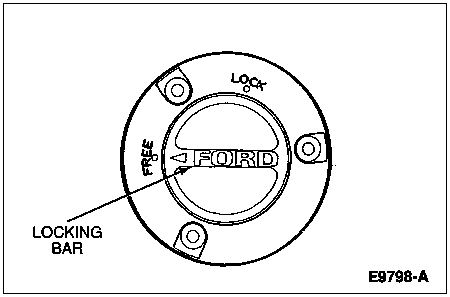Section 05-03C: Wheel Hubs and Bearings, Front Wheels, 4-Wheel Drive | 1996 F-150, F-250, F-350, and Bronco Workshop Manual |
The hublocks on F-150, F-250, F-350 and Bronco 4x4 vehicles equipped with 4-wheel drive either automatically or manually actuate the front driving axle. When actuated, the hublock body locks the hub and wheel (1007) and tire assembly to the halfshaft (3A329). When released, the axle shaft is disengaged from the front disc brake hub and rotor (1102) and the wheel rotates freely on the front wheel spindle (3105).
F-350 4x4 vehicles equipped with dual wheel rear axles (4001) have the outer wheels and tires attached with integral two-piece swiveling lug bolts (1107).
![]() WARNING: DO NOT USE OLDER DESIGN LUG BOLTS (CONE-SHAPED, ONE-PIECE) TO REPLACE THE CURRENT INTEGRAL TWO-PIECE SWIVELING LUG BOLTS. OLDER DESIGN LUG BOLTS CAN COME LOOSE DURING VEHICLE OPERATION. DO NOT USE OLDER DESIGN WHEELS, WHICH HAVE CONE-SHAPED SEATS FOR THE LUG BOLTS, ON THIS VEHICLE. DO NOT USE THE CURRENT DESIGN WHEELS OR LUG BOLTS ON OLDER DESIGN VEHICLES AS THIS CAN DAMAGE THE WHEEL MOUNTING SYSTEM AND COULD RESULT IN WHEELS COMING LOOSE DURING OPERATION.
WARNING: DO NOT USE OLDER DESIGN LUG BOLTS (CONE-SHAPED, ONE-PIECE) TO REPLACE THE CURRENT INTEGRAL TWO-PIECE SWIVELING LUG BOLTS. OLDER DESIGN LUG BOLTS CAN COME LOOSE DURING VEHICLE OPERATION. DO NOT USE OLDER DESIGN WHEELS, WHICH HAVE CONE-SHAPED SEATS FOR THE LUG BOLTS, ON THIS VEHICLE. DO NOT USE THE CURRENT DESIGN WHEELS OR LUG BOLTS ON OLDER DESIGN VEHICLES AS THIS CAN DAMAGE THE WHEEL MOUNTING SYSTEM AND COULD RESULT IN WHEELS COMING LOOSE DURING OPERATION.
The Touch Drive 4x4 system allows the driver to engage four-wheel drive at the touch of a button instead of pulling a shift lever. This button is connected to an electronic control module that controls the functions necessary to engage the transfer case (7A195).
When the 4x4 button is depressed, the electronic control module energizes the electronic clutch coil in the transfer case. This accelerates the front axle shafts up to the same speed as the front wheels. As the axle shafts begin to rotate, they engage the automatic hublocks located at each wheel end. After approximately 5 seconds, the transfer case clutch coil turns off. A stepper motor located on the back of the transfer case then locks up the transfer case via a camming mechanism and a locking collar. The entire sequence takes only a few seconds.
To disengage the transfer case, again depress the 4x4 button. This will unlock the transfer case but the automatic hubs will remain locked. To unlock the hubs, back up the vehicle for at least 10 feet, then continue in the original direction. Because the front axle has been disengaged from the transfer case, the hubs will remain unlocked.
Buzzing and ratcheting noises were a constant concern with older 4x4 vehicles. These noises occurred usually when shifting into 4-wheel drive after starting a vehicle that had been sitting cold for several hours. The noises would also occur just after shifting from 4-wheel drive to 2-wheel drive. Cold weather was another factor that produced the noise concerns. Colder temperatures increased the viscosity of the axle lubricant, resulting in a much higher torque requirement for the transfer case clutch that could only rotate the pinion gears enough to cause the hubs to partially lock, which resulted in a ratcheting noise.
The newer vehicles, however, utilize a 75W axle lubricant with low viscosity and a transfer case clutch with a higher output. Both innovations allow for 4x4 operation in extreme temperature conditions.
Noise concerns in 2-wheel drive, just after shifting from 4-wheel drive, can occur if one of the hublocks fails to disengage. As the vehicle moves forward, the one hublock that has failed to disengage will rotate its axle shaft through the differential and attempt to rotate the other axle shaft in the opposite direction. As the opposite shaft turns in the reverse direction, the hublock will attempt to engage (sometimes referred to as differential motoring torque), which will result in a ratcheting or buzzing noise.
This type of noise concern is usually found on axles that have very few 4x4 miles on them. As the front axle accumulates a minimum of 250 miles of locked hub operation, the axle will break in, which reduces the amount of differential motoring torque significantly. To accomplish this, engage 4-wheel drive and then shift out of it without disengaging the hubs. This will break in the axle. Should the vehicle be put in reverse gear during this time period, the hubs will disengage and will have to be locked again by repeating the engagement procedure.
The manual locking hubs must be engaged and disengaged by hand. To engage the hubs for 4-wheel drive, grasp the locking bar in the center of the hub and rotate it clockwise to the LOCK position. The arrow on the locking bar must line up with the marker on the hub at the LOCK position. To disengage the hubs for 2-wheel drive, grasp the locking bar and rotate it counterclockwise toward the FREE position until the arrow on the locking bar is lined up with the marker on the hub at the FREE position.
Manual Locking Hub